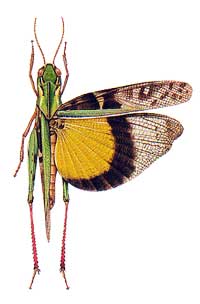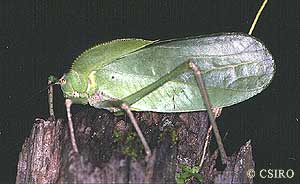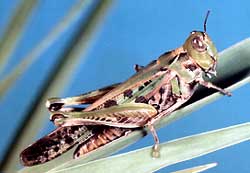|
Orthoptera:
grasshoppers and locusts
For more information on plague locusts
visit the Australian
Plague Locust Commissiontralian
Plague Locust Commission
Characteristics
Grasshoppers,
crickets, katydids and locusts all belong to the order Orthoptera
which means 'straight wings'. Most are easily recognisable by their
hind legs, which are usually enlarged for jumping. They are often
easily seen jumping away when disturbed or heard 'singing' at night.
They are mainly medium to large insects with some species in Australia
growing to a length of 10 centimetres. There are about 3000 species
in Australia and all can be distinguished from other insects by
the following features:
|

Gastrimargus
musicus
(yellow-winged locust)
|
|
- 2 pairs of
wings. The forewings are narrower than the hind wings and hardened
or leathery at the base. They are held roof-like overlapping the
abdomen at rest. The hind wing is membranous
and held folded fan-like under the forewings when at rest
- Antennae
may be short to very long depending on the species. Grasshoppers
have relatively short antennae while crickets and katydids generally
have long antennae
- Hind legs
are enlarged and modified for jumping
The general
appearance of this order makes it difficult to confuse with other
insects. The young of Orthoptera look like small wingless adults.
Many orthopterans can produce sound by rubbing their legs, wings
or abdomen together. It is predominantly males that produce these
sounds to attract females.
Life Cycle
Orthopterans
develop by incomplete
metamorphosis. The majority of orthopterans lay their
eggs in the ground or on vegetation. The eggs hatch and the young
nymphs
resemble adults but lack wings and at this stage are often called
hoppers. Through successive moults
the nymphs
develop wings buds until their final moult
into a mature adult with fully developed wings. The number of moults
varies between species but grasshoppers may have up to 6 while crickets
may have up to 10. Growth is also very variable and may take anywhere
from a few weeks to many months depending on such things as food
availability and weather conditions.
|

Siliquofera grandis
|
Feeding
Most orthopterans
are herbivorous
feeding on a variety of plant materials including roots. Most short-horned
grasshoppers feed on grasses while many long-horned grasshoppers
(such as katydids) and crickets tend to be more omnivorous.
Some species are even scavengers
or predators.
Habitat
Orthopterans
are found in all terrestrial habitats across Australia. They are
commonly in association with vegetation, from ground level to the
canopy, in burrows in the soil or moving across open ground, depending
on the species. Most are active during the day, feeding on vegetation
and others such as mole crickets spend most of their time in underground
burrows. Orthopterans are usually found singularly or in small numbers,
however a few species sometimes increase in numbers forming plagues
that can cause much damage and huge crop losses, such as the Australian
plague locust pictured below.
|

Chortoicetes terminifera (Australian plague locust)
|
|



